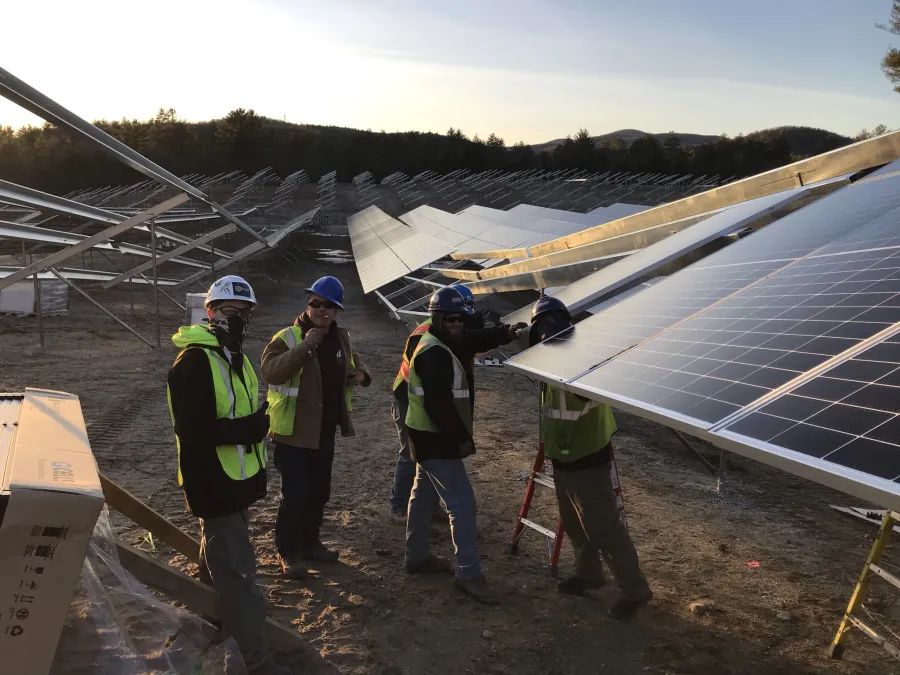A Record Number of IBEW Apprentices Working in the Field Installing Solar

IBEW Locals 567 and 1253 are putting a record number of electrical apprentices to work in the field as Maine’s boom in solar power installations and construction continues. Currently, the two locals have a combined total of more than 200 apprentices working on various projects.
Currently IBEW 1253 in Newport has about 93 apprentices out in the field working and IBEW 567 in Lewiston has 114 apprentices working everywhere from grid-scale solar arrays, mills and construction projects. When it comes to apprentices, both unions currently have an "empty bench" with all of their apprentices working. According to IBEW 567 Training Director Justin Walsh, during the past two years the local has doubled the number of classes offered for first-year apprentices and took in 35 new apprentices this year alone. By comparison the local had just one IBEW 567 apprentice graduate in 2017.
“Solar is definitely driving a lot of our business and we took in a lot of kids based on how much solar work there is,” said Walsh. “Up until four years ago, I don’t think we had ever worked on a solar project before. Then all of a sudden a few solar projects popped up here and then they just started getting bigger and bigger. It hasn’t stopped since then.”
Walsh estimates that the local accepted about 30 percent of new apprentices to meet the rapid increase in solar installations, which were made possible thanks to the state’s investments in renewable energy to meet Governor Janet Mills’ goal to more than double the number of clean energy jobs to more than 30,000 by 2030. In 2019, the Legislature passed and Governor Mills signed one of the most ambitious renewable energy requirements in the country, increasing Maine’s Renewable Portfolio Standard from 40 percent to 80 percent by 2030 and setting a goal of 100 renewable energy by 2050.
Construction in general is also booming and the IBEW 567 recently signed a contractor that is working on large substations and other commercial projects. George Howe, director of the Augusta Electrical JATC Apprenticeship program with IBEW 1253, is currently trying to take in an additional 20 to 30 new apprentices on top of this year's first year class and get them tested, interviewed and into a class early so they can get to work out in the field.
“I don’t think we’ve ever been this busy. It’s great for the local and great for the apprenticeship program,” said Howe. “A lot of it is solar, but the industrial market is also busy. We have a decent number of commercial jobs going. Construction as a whole seems to be moving forward pretty rapidly.”
Building trades unions are a good reliable source of labor for contractors because they can also bring in traveling members from other locals across the country to work on projects in Maine. Union leaders, say that because electricians are in such high demand, contractors in Maine are paying well over scale and offer per diems that are much higher than previously offered. Walsh says that solar is now driving up wages for other industrial projects.
“On solar projects contractors are paying rates well over scale because they know that’s the only way to attract workers,” said Walsh. “They’re not going to work outside all winter long when they could work inside somewhere else for the same rate. So they’re paying over wage and over scale.

IBEW 567 apprentice Ted Closson, who happens to also be an award-winning comic artist and writer, said a union apprenticeship was the best pathway for him to become an electrician after leaving his previous career in health care.
As he called around to local electricians to ask about how to get into the trade, the process seemed very daunting, especially as an older worker with a family to support. A union apprentice gave him a simple and clear career pathway by putting everything into one package, from the classes and work hours all the way to the eventual journeyman’s certification. He could also get paid at the same time and come out the program without any debt.
“A lot of the young people who are coming into the electrical trade are in vocational tech programs and they’ve got teachers who know their work ethic and can push them in the right direction. As someone making a career change, I didn’t have that kind of guidance,” said Closson. “When I called IBEW 567, I spoke to training director Justin Walsh, who told me he too had transitioned into the trade from another career. I realized then that I could do this.”
Closson said investing in renewable energy is critical to protecting the future of the planet as well as providing excellent career opportunities in Maine.
“Renewable energy is the future,” he said. “Our state motto is Dirigo, ‘I lead,' and I think this is an area where we are leading because we are making the necessary investments and we have enough land to make this viable. It’s also a way to for people to cut their electricity costs.”
George Howe of IBEW 1253 said the future is looking very bright for union electrical workers in Maine.
“It sounds like the next couple of years industrial work is going to give solar a run for its money as far as how busy our contractors are going to be,” said Howe. “Whether it’ll be working in the mills or the proposed fish farms on the coast, it appears that our members will have steady work for many years to come.”
Are you interested in an electrical apprenticeship with IBEW? Contact our Peer Workforce Navigator, Leslie at maineaflcio dot org, 207-441-5023 and she can connect you. You can also learn more and apply online:IBEW 567 apprenticeship and IBEW 1253 apprenticeship.
